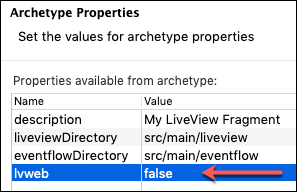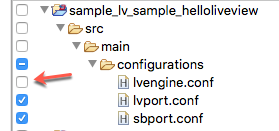Contents
TIBCO® Data Streams 11.0.1 adds the following updates and new features:
- TIBCO® Data Streams Now Supports Debian Linux 11
-
Debian Linux is now a supported operating system for deployment.
- TIBCO® Data Streams Now Bundles Java 11.0.16
-
On all supported operating systems, the TIBCO® Streaming installation kit provides the runtime components of Oracle JDK version 11.0.16 in a subdirectory of the Streaming installation directory, for private use to run Streaming fragments and applications from within StreamBase Studio. As before, Streaming detects and prefers a system-installed JDK, and uses the bundled JDK as a fallback. See further details about the JDK requirements of this release in the JDK entry of the Supported Configurations page.
- Jetty Upgraded
-
The Jetty web server version was upgraded to 9.4.48 to address security issues in the previously supported version. The upgrade applies, for example, to the TIBCO StreamBase® Web Server Request adapter and the TIBCO StreamBase® Web Server Response adapter, as well as for developing your own applications that require Jetty.
- Added Discovery Mechanism to Work Cross-Namespace
-
Previously, EventFlow pod installation used to fail because Kubernetes-based service discovery was not available in cluster. From this release, Kubernetes-based service discovery mechanism now works with cross-namespace.
- TIBCO® Streaming Now Uses OpenShift 4.10
-
From this release, TIBCO Streaming uses OpenShift 4.10 and later instead of 4.6 as in the previous version.
- UMDF Adapter Now Uses New Version Of FIX Antenna Java
-
From this release, UMDF adapter uses version 2.24.1 for FIX messages and and version 2.14.26 for FAST messages.
The following features are deprecated as of Streaming 11.0.1.
- FIX-based adapters' support for QuickFIX/J Engine Deprecated
-
Currently all FIX-based adapters offers a choice between using QuickFIX/J engine or the High-Performance FIX (HPFIX) engine of TIBCO®. Going forward, HPFIX must be used as support for QuickFIX/J will be removed in an upcoming version of the product.
- TIBCO® Artifact Management Server Deprecated
-
TIBCO® ModelOps is a new offering that builds on the capabilities of TIBCO® Artifact Management Server with more sophisticated governance and artifact management capabilities. TIBCO® Artifact Management Server remains supported for the 10.6 LTS release support period, which ends on May 31, 2025.
- FastJSON Dependencies Removed from Adapters
-
FastJSON dependencies are removed from all adapters.
- C++ Client APIs are now Deprecated
-
There is no replacement for the C++ APIs and the client code must be migrated to one of the other supported language bindings such as Java, .NET, and Python.
- sbc and sbadmin Command Line Tools are now Deprecated
-
sbc and sbadmin command line tools are now deprecated. The functionality of these command line tools has been replaced with epadmin and any use of them should be migrated to epadmin.
This section describes known limitations as of the current release of TIBCO® Data Streams. Each item includes a tracking number, description, and workarounds when possible.
Known limitations for using the EventFlow debugger are described separately, in the Limitations, Tips, and Tricks section of the Using the EventFlow Debugger page.
This page describes the known limitations in the current release of TIBCO LiveView™. Each item includes a tracking number, description, and whenever possible, one or more workarounds.
| ClusterAlert | Cluster-wide Alert Group Restriction for Heterogeneous Clusters | |
| Description | Nodes with only EventFlow engines in LiveView clusters must be in their own alert groups. | |
| Workaround | See this page for cluster-wide alerting guidelines. | |
| SB‑46418 | Removing lvweb.war dependency from a project's POM does not remove the file, and vice versa.
|
|
| Description | New LiveView Fragment projects are created by default with a dependency on the
lvweb.war file that implements the LiveView Web functionality.
There are two cases: (1) If you later edit the project's pom.xml
file to remove that <dependency> element, doing so does not
automatically remove the lvweb.war file from the project's
src/main/liveview/lv-user-webapps folder. (2) If you remove the
lvweb.war file manually, the pom.xml is not
automatically edited to remove the dependency.
|
|
| Workaround | In both cases, to remove a project's support for LiveView Web, you must remove the
lvweb.war file and edit the pom.xml file
.
The correct way to create a new LiveView project without
LiveView Web support is to change the
|
|
| SB‑45720 | Failure to independently run or debug EventFlow modules in LiveView projects in 10.4.0 -10.4.2. | |
| Description | Many LiveView projects have StreamBase EventFlow modules that provide functionality such as publishers or transformers of data. In releases 10.4.0, 10.4.1, and 10.4.2, right-clicking such modules and selecting > (or ) to run or debug the module independent of the enclosing LiveView project resulted in an error. This feature was restored in release 10.4.3. This limitation did not prevent running the project as a LiveView fragment with all EventFlow modules working; the limitation was only on running the EventFlow modules by themselves. | |
| Workaround | If you are using one of the affected releases, you can perform the following tasks:
|
|
| SB‑44494 | Metadata store restriction for clusters containing LiveView and StreamBase fragments. | |
| Description | The transactional memory metadata store type is only supported on homogeneous LiveView clusters. This means the cluster cannot contain a mix of LiveView and StreamBase fragments when using a transactional
memory metadata store.
|
|
| Workaround | Use either the JDBC or H2 metadata store type when your cluster contains both LiveView and StreamBase fragments. | |
| CQS-4800 | Row level security (RLS) authentication is not performed on results for the already-registered queries and query-based alerts. | |
| Description | Row level security (RLS) authentication and authorization is performed at the time when new query-based alerts and queries are registered with the LiveView server. LiveView does not perform authentication on the results of already-registered queries and query-based alerts; to get the expected results based on RLS authentication, you must re-register the queries with the server. | |
| Workaround | None. | |
| CQS-4748 | Do not use the liveview.project.out system property.
|
|
| Description | It was a best practice to use the liveview.project.out system
property in previous releases to manage the placement of the LiveView server's
compilation working directory. However, if you redirect this working directory in
StreamBase 10 applications, the StreamBase application might fail to start
correctly.
|
|
| Workaround | None. | |
| CQS-4641 | Issuing queries with literal non-printing characters are not supported in query strings. | |
| Description | Query strings with literal non-printing characters can cause issues. Non-printing characters are those below 0x20, excepting tab, carriage return, and line feed. Note that tables and query result sets are free to have any characters as values. | |
| Workaround | Instead use StreamBase Unicode escape sequences, which looks like \uXXXX. For example, a bell is \u0007.
|
|
| CQS-3855 | Remote data source tables with sole primary key CQSInternalID cannot be opened.
|
|
| Description | When querying a remote data source's tables, all LiveView clients fail to open any
remote table that uses a single primary key named CQSInternalID.
This issue affects all LiveView clients, including TIBCO LiveView Desktop, TIBCO LiveView Web, the lv-client command line utility, and any custom client written by using LiveView Client APIs. The issue occurs when querying any remote data source, including: TIBCO StreamBase Query Tables, other LiveView servers, JDBC databases, TIBCO ActiveSpaces tables, and custom table providers. |
|
| Workaround | To enumerate the remote tables that you must avoid, you can use one of the
following suggestions: 1. If your client can sort its list of available remote tables,
sort it by the Indexes column to isolate the tables that have only CQSInternalID as
their primary key. 2. To determine the remote tables to avoid opening, use the following
query:select * from LVTables where Indices=='CQSInternalID' |
|
This section provides a list of errors corrected in release 11.0.1 of TIBCO® Data Streams.
| Fixed in 11.0.1 | |
|---|---|
| Number | Resolution |
| TIBCO® Streaming 11.0.1 incorporates all fixes resolved in the release 10.0.0-10.6.3. | |
| SB-51994 | FastJSON was previously announced as having been removed, however this was incorrect as there remained one use in the Webserver Adapter. This dependency is now removed. |
| SB-51607 | The Database Change Data Capture (CDC) adapter was not using the JDBC Data Source HOCON configuration to enable pooling options. Because of this, CDC Adapter could not monitor multiple CDC-enabled tables efficiently. |
| SB-51813 | The source Distributed Router now receives the notification that the target node has become available and delivers the queued tuples for that node and reports the change from the Status output port. No queued tuples are dropped. |
| SB-51861 | The Legacy Decision Table operator was not updating the latest version of the
.sbdt file despite the server UI and logs reporting that the
deployment was successful.
|
| SB-51809 | Two security vulnerabilities were identified in the Spring Framework that enable unauthenticated Remote Code Execution (RCE). The vulnerability impacted Spring Framework, which includes Spring MVC and Spring WebFlux applications running on JDK 9+. Spring libraries were updated accordingly to fix this. |
| SB-49285 | The Aggregate operator emits a window but does not close the window if the output tuple hits an Error Output Stream within the region. This behavior differs from StreamBase 7.7, which closes and clears the window regardless of whether an error is reached later. |
| SB-51920 | "LiveViewException: Unauthorized" error occurs when trying to authenticate using a secured LDAP server. |
| SB-51953 | In Debug Mode, launching or deploying StreamBase EventFlow Fragment use to hang if any module had a breakpoint set. |
| SB-52045 |
While defining variable name in Japanese in Dynamic Variables Tab of Streaming Studio, Streaming adds the # pound char in front of Variable name. This causes the error at the beginning of application leading to end the application. |


